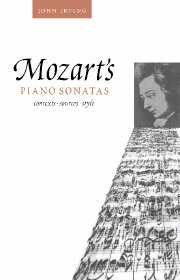Book contents
- Frontmatter
- Contents
- Epigraph
- Preface
- Acknowledgements
- Abbreviations
- PART I CONTEXTS
- PART II SOURCES
- 3 Six sonatas, K.279–84
- 4 Three sonatas, K.309–11
- 5 Four sonatas, K.330–2; K.333
- 6 Fantasia and Sonata in C minor, K.475 and 457
- 7 Later Viennese sonatas, K.533 and 494; K.545; K.570; K.576
- 8 Fragments
- PART III STYLE
- Notes
- Select bibliography
- Index
7 - Later Viennese sonatas, K.533 and 494; K.545; K.570; K.576
Published online by Cambridge University Press: 15 December 2009
- Frontmatter
- Contents
- Epigraph
- Preface
- Acknowledgements
- Abbreviations
- PART I CONTEXTS
- PART II SOURCES
- 3 Six sonatas, K.279–84
- 4 Three sonatas, K.309–11
- 5 Four sonatas, K.330–2; K.333
- 6 Fantasia and Sonata in C minor, K.475 and 457
- 7 Later Viennese sonatas, K.533 and 494; K.545; K.570; K.576
- 8 Fragments
- PART III STYLE
- Notes
- Select bibliography
- Index
Summary
Of Mozart's four remaining solo sonatas composed between January 1788 and July 1790, the only surviving autograph material presently known is a portion of the first movement of the B flat Sonata, K.570 (bars 65 to the end). First editions of all these works survive, though in three cases (K.545, K.570 and K.576) they appeared after Mozart's death. The extent to which their texts may be trusted is debatable:
The first edition of K.570 is evidently corrupt in that it includes an obbligato violin part, of which there is no trace in the surviving pages of the autograph. (In the Verzeichnüss, Mozart describes K.570 as a sonata ‘auf Clavier allein’.) Perhaps details such as the articulation of the opening theme are not faithfully reproduced in the first edition either: Mozart's notation of this theme in his Verzeichnüss joins together bars 1 and 2 under a single slur before continuing with the same one-bar grouping as in found in the edition. On the other hand, Mozart himself may not have been very consistent here, for at bars 41 ff. and several other passages, the autograph has the same one-bar slurring as the print, and at bars 101 ff., where Mozart begins to develop the theme, the autograph notates the entire four-bar figure under a single slur. Unfortunately, we do not know precisely how Mozart notated the first four bars of the piece since, in the autograph, not only are the first sixty-four bars lost, but the first part of the recapitulation (bars 133–64, which may have retained the original phrasing) was indicated merely as a Da Capo.
[…]
- Type
- Chapter
- Information
- Mozart's Piano SonatasContexts, Sources, Style, pp. 83 - 88Publisher: Cambridge University PressPrint publication year: 1997

